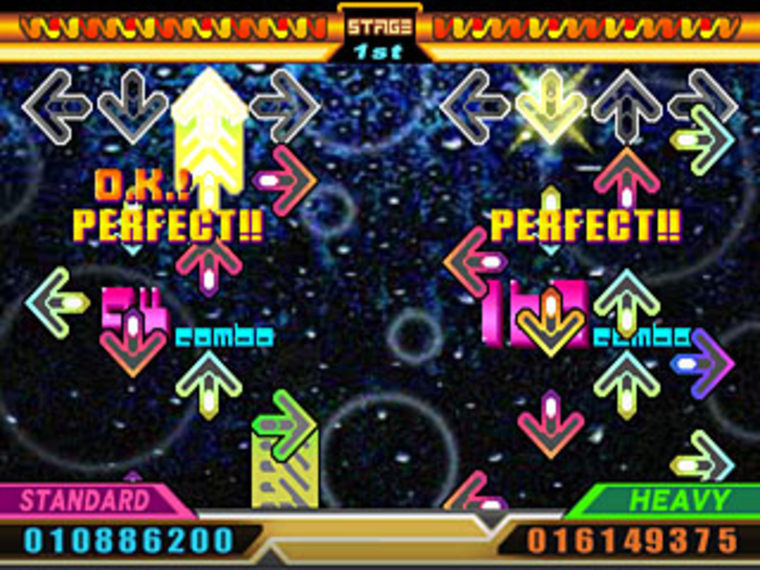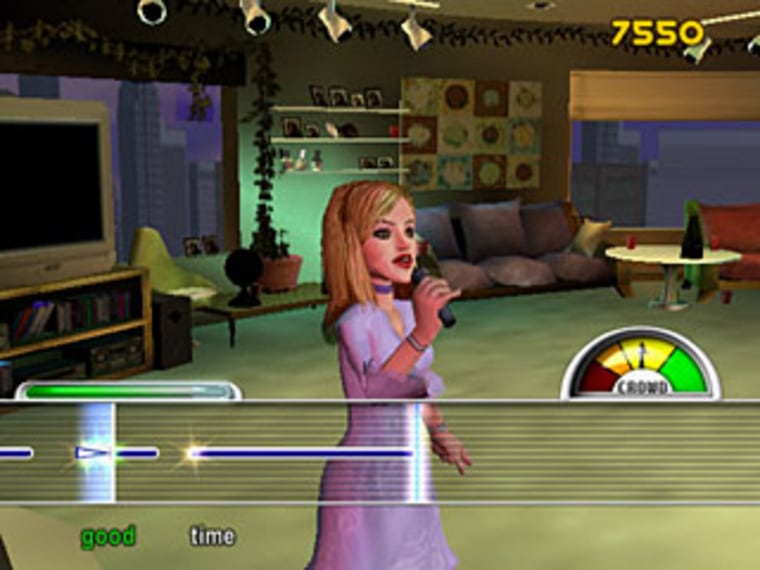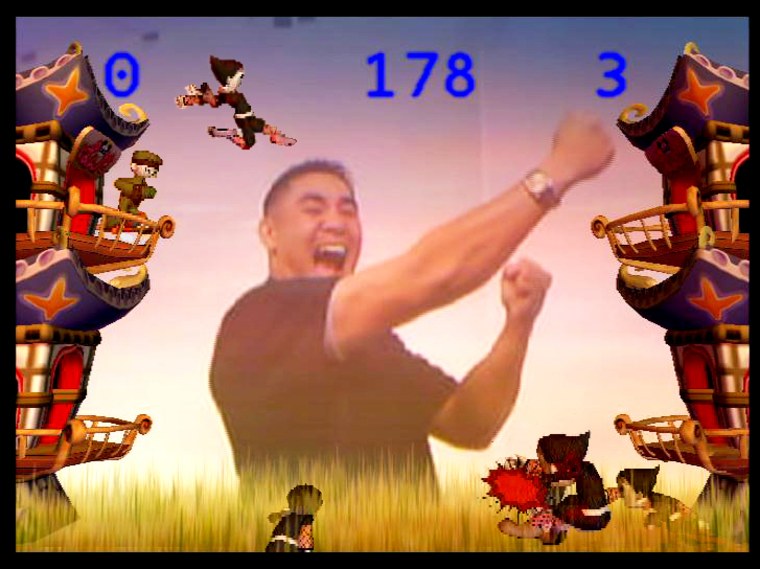Once, Christmas morning would find the streets thronged with kids pushing, pedaling or throwing their new toys. Video games have since usurped dirt bikes as the gift of choice and the excited street-side chatter has been replaced by the sounds of digitized explosions in the family room. But while gaming has moved celebration indoors, it hasn’t made the holiday any less social. This season’s collection of game hardware encourages gamers to get up and spread a little holiday cheer.
Work off that turkey
Want to find out who’s been dipping into the ‘nog? Line them up in front of Sony’s EyeToy for the PlayStation 2. The EyeToy is a small camera that attaches to the PS2’s USB port. When used with its included suite of games, the EyeToy pulls the player into the middle of the action onscreen. This is a no-joystick environment where the player’s movements control the play. Swat at balloons, juggle balls, karate-chop an entire Shaolin Temple of fighters – players will be working off that turkey in no time. And as for that person with a little too much holiday cheer ... load up the included Mirror Game where the player’s onscreen image flips, mirror-like, multiple times, turning the simple task of popping balloons into a discombobulating mess. Onlookers are advised to stand back, way back.

"DDRMAX 2 Dance Dance Revolution" is sure to be another holiday party starter. This is the umpteenth edition of the dancing game where players must move their controller or feet on beat in the direction of onscreen arrows. The new edition of "DDRMAX 2" ships with a Dance Mat, a mandatory upgrade for those wanting to transform the holiday hearth into a suburban Studio 54.
The Sony Eye Toy, $49.99. "DDRMAX 2 Dance Dance Revolution" (game only), $36.95. "DDRMAX 2 Dance Dance Revolution" with Dance Mat, $79.95.
Jingle Bell rock

What’s a holiday family gathering without karaoke? Probably better. But karaoke’s discovery of the console means that some lucky PlayStation 2 and Xbox owners will receive the "gift" of muzak. In "Karaoke Revolution" for the PlayStation 2, players choose from a song library of schmaltz and a mall-friendly teen avatar to belt it out. As the lyrics slide across the screen, players must hit their notes at an acceptable pitch and for the right length to score points. Fail and the crowd gathering onscreen will boo your avatar – sending him or her to a lifetime working at Hot Dog on a Stick. Cheesy? Of course. And the included headset that makes players feel like Madonna on her conical bra tour doesn't help. But the cheese is what makes "Karaoke Revolution" far superior to the "Xbox Music Maker," Microsoft’s karaoke and microphone package which lacks the funny animations, the song list of pop dreck and thus the fun. (MSNBC is a Microsoft - NBC joint venture.) The "Xbox Music Mixer" boasts vocal stripping technology – burn a CD onto the Xbox and sing along – but the technology strips out much of the rhythm section as well. And although the "Music Mixer" allows Xbox Live subscribers to download songs and lyrics, that’s no excuse for the paltry song library. Among the 15 songs included: "Auld Lang Syne." Ring in the New Year by being the first person who actually knows the lyrics.
"Karaoke Revolution" with headset, $59.99. "Karaoke Revolution" (game only), $39.99. "Xbox Music Mixer," $39.99.
Planning for springSome may want to use the holidays to get their PC up-to-snuff for the graphics-rich, memory-draining first-person-shooters due out this spring. Nvidia and ATI, the two leading graphics card manufacturers, each introduced high and medium-end cards just in time for the holidays. ATI’s Radeon 9800XT won't win any best budget awards, but for the discriminating PC gamer who can’t play anything below a 1600x1200 resolution it could be the only option. The 9800XT boasts 256 MB in graphics memory. (The recipient of a 9800XT will not be coming out to the family room to sing karaoke.) ATI’s Radeon 9600XT is priced for the mainstream, but still built to handle "Half-Life 2" and "Doom III."
Or maybe the PC gamer won’t need a graphics card after all. A web-based tool allows PC gamers on the XP platform to measure their machine’s performance against a game’s demands. After logging on to and selecting from one of the hundreds of game listed on the site, gamers will receive an online report detailing whether their machine makes the cut.
ATI’s Radeon 9800XT, $499.99. ATI’s Radeon 9600XT, $199.99. Nvidia' s GeForce FX 5700, $219.99. PortablesOne day the holiday season must come to an end and then it’s back to work. For the corporate climber too ashamed to admit to owning a Game Boy there’s the Tapwave Zodiac, a hand held game platform that looks like a personal digital assistant. The Zodiac actually is a PDA: complete with a Palm OS and the requisite suite of PDA applications – date book, alarm and organizer. But the Zodiac got it right in believing that their clientele can spend only so much time on the subway or in the car pool fiddling with their date book before wanting to blast away at demon spawn. The Zodiac boasts a graphics accelerator and 16-bit color display built for gaming. Available now is the arcade classic "SpyHunter"'; titles like "Doom II" and "Neverwinter Nights" are due out in the near future. A built-in Bluetooth radio enables multiplayer gaming.

The Tapwave follows on the coat tails of Nokia’s N-Gage. Released in September, the N-Gage promised a revolution in portable technology; combining a cell phone with a sophisticated game platform. Initial reviews cited weren’t positive: complaints ranged from "N-oying" to "N-ourmous." But a subsequent price drop and new titles including "Splinter Cell" and "Red Faction" has led to a trickling of starred reviews. Like the Zodiac, the N-Gage includes Bluetooth and an mp3 player.
Of course there’s always the top-selling handheld game platform, the Nintendo Game Boy Advance. While the Game Boy has done nothing of particular interest of late, it does now come in two new colors, "Flame" (red) and "Onyx" (black), for the gamer-on-the-go who demands style as well as performance.

And for the gamer who has everything, there is the ultimate in laptops, the Area51m from Alienware, which earns style points for its alien-inspired design. But it's the Intel Pentium 4 processor, the graphics accelerator (like the 128 MB ATI Mobility Radeon 9600) and powerful speakers (for a laptop) that provides the Area51m with the power to rival desktops. The Area51m is also built to make it easy for users to upgrade video cards -- a major challenge for most laptop owners.
Tapwave Zodiac with 32MB or 128 RAM, $299/$399. Nokia N-Gage, $199. Nintendo Game Boy Advance SP, $99. Alienware Area 51m, starting at $2,076.
Stocking stuffersThose looking for game ideas for the gamer in their life should consult last week's roundup of hot titles -- including two of my favorite December releases, "Prince of Persia: The Sands of Time" and "Mario Kart Double Dash." But for those who can’t tell the difference between a MMORG and an FPS, the no-risk solution may be a gift certificate from Gamerang, an online game rental service. Members can rent as many PS2, GameCube, Xbox and GameBoy Advance titles as they want and keep each game as long as they want (no late fees!) provided one game is checked out at a time.

Or perhaps the answer lies in some old school technology: Books. Yes, books, lines of words strung together, forming sentences and then printed on paper and bound together.
"Masters of Doom" tells the tale of how John Carmack, John Romero and others changed gaming forever with "Doom" and put Mesquite, Texas on the map. Another 2003 release, "Dungeons and Dreamers: The Rise of Computer Game Culture from Geek to Chic" follows computer gaming, particularly role playing titles, from its text-based MUD days through Richard Garriot’s "Ultima" empire. It’s a great study of how an unlikely assortment of midnight programmers and "Dungeons and Dragons" gamers, through their duel passions for computers and story-telling, laid the foundation for a multi-billion dollar industry.
Gamerang monthly subscription, $14.95. "Masters of Doom," $24.95. "Dungeons and Dreamers", $24.99.
When not babbling about computer games, Tom Loftus produces interactives for MSNBC.com
